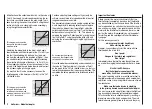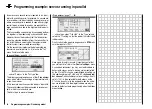
86
First steps in programming a new model
Example: non-powered fi xed-wing model aircraft
When programming a new model you should start with
the ...
„Select model“
sub-menu (page 36)
... in the »
Model memory
« menu, where you select a
vacant memory and confi rm your choice by pressing the
ENTER
or
SELECT
button.
Once you have selected a empty model memory, you
are requested to select the type of model to be program-
med.
Since in this example we are programming a fi xed-wing
model, we select the fi xed-wing model symbol using the
right-hand rocker button, and confi rm with
ENTER
or
SELECT
. The screen now reverts to the basic display.
Once you have called up the “Model select” option it is
not possible to interrupt the process, i.e. you must choo-
se one or other model type. However, if you make a mis-
take you can always correct it simply by erasing the mo-
del memory.
Now that you have overcome this fi rst hurdle, you can
start programming the actual transmitter settings to suit
the model in the ...
»Base settings«
(page 38 … 41)
At this point you can enter the “
Model
name
”, check the
settings for “
Stick
mode
”, “
Modulation
”, and “
Motor
at
C1
” and change them if necessary:
• “none”: trim works independently of the stick position.
• “Throttle min. front or rear”: C1 trim works on idle ran-
ge (forward or back) only. If the throttle stick is in the
“full-throttle” direction when you switch the transmit-
ter on, you will be warned of this with the message
“Throttle too high”.
Note:
Selecting “motor” or “no motor” also affects the range of
mixers available in the »
Wing mixers
« menu. For this
reason we shall fi rst consider “none” (no motor) in the
following programming example.
In the next two lines you select the basic arrangement
of the servos in the model, and inform the transmitter of
your choice:
Tail type:
“Normal”, “V-tail”, “Delta / fl ying wing”
or “2 elev sv”
Ailerons / fl aps:
1 or 2 aileron servos and 0 or 2 fl ap
servos
Note:
If your model is fi tted with only one camber-changing
fl ap servo, you should still select “2FL”. Later, in the
»
Wing mixers
« menu (see page 61), you should se-
lect the “Ail
fl ap” mixer and set it to 0%. You can still
exploit all the other mixers available at that point in the
usual way.
At this juncture – if not before – you should check that
the servos are connected to the receiver in the standard
Graupner
sequence:
Notes:
If you set up a V-tail, but the “up / down” and / or “left /
right” functions work the wrong way round, please re-
fer to the table in the right-hand column on page 30. The
same procedure can be used if you set up fl aperons
(superimposed ailerons and fl aps), and they work the
wrong way round.
The following settings apply to a model with a “normal”
tail and no motor (“none”); if your model has a V-tail the
settings can be adopted virtually unchanged. However,
if the model is a delta or fl ying wing, the situation is not
quite so straightforward. A special programming examp-
le covering this model type will be found in the section
starting on page 97.
Programming examples: Fixed-wing model
7
6
5
4
3
2
1
8/Ba
tt.
CRO-SUPERHET
6
FM
Best.-Nr.
7052
0-282/182-191
MHz/35MHz-B-Band
Made in Malaysia
S C A N
! #
Y-lead, Order No.
3936.11
or
3936.32
Battery
Auxiliary function
Right fl ap servo
Flap servo or left fl ap servo
Right aileron servo
Rudder servo or V-tail
Aileron servo or left aileron servo
Airbrakes or throttle / speed controller
Elevator servo or V-tail
Summary of Contents for MX-16S
Page 1: ...1...
Page 17: ...17...
Page 31: ...31 Fixed wing models Installation and connections...
Page 35: ...35 Program description Reserving a new memory...
Page 47: ...47 Base settings Model helicopter...
Page 83: ...83 Fail safe...
Page 89: ...89 Programming examples Fixed wing model...
Page 109: ...109 Programming examples Model helicopter...
Page 112: ...112 112...
Page 116: ...116...






























